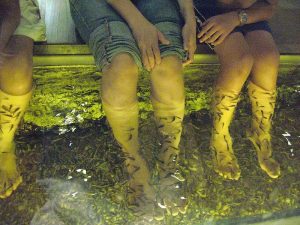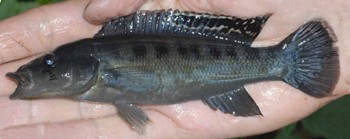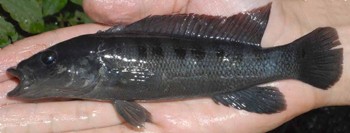Tag Archives: Fish
“How many fish in the Sea?”
The first global census of life in the sea has logged some 230,000 species, however a ten year study on the subject performed by over 300 scientists warns of mass extinctions.
This ten year study has been the largest, most extensive study to attempt a stab at that age old question “Just how many fish are there in the sea?”
The ten year study, which was published today, is attempting to answer that question. It has analyzed the diversity, distribution and abundance of life in the world’s oceans. This study, dubbed The Census of Marine Life, hopes to give a ballpark estimate of the present marine life, and has estimated that there are more than 230,000 species living in our oceans.
“From coast to the open ocean, from the shallows to the deep, from little things like microbes to large things such as fish and whales,” explained Patricia Miloslavich of Universidad Simón Bolívar, Venezuela and co-senior scientist of the COML.
The study which was carried out also covers animals such as; crabs, plankton, birds, sponges, worms, squids, sharks and slugs.
Moe than 360 scientists from around the world got together and have spent the past ten years surveying 25 different regions, ranging from the Antarctic through the more temperate and tropical seas, to the Arctic, to attempt a head count of the different kinds of plants and animals.
The results of the study show that just about twenty percent of the marine species of the world are crustaceans such as lobsters, krill, barnacles, and crabs. Toss in Molluscs (such as squid and octopus) and fish (which include sharks) and that adds up to half of the number of species which are found in the oceans of the world.
The charismatic species often used in those ecological conservation campaigns – sea lions, turtles, whales and sea birds – make up less than 2% of the species in our world’s oceans.
Which is really interesting when you think about it.. We tend to only take notice of the species right on the surface, without really giving a second thought to those that dwell within the depths..
The surveys also pointed out the major areas of concern for the conservationist groups. “In every region, they’ve got the same story of a major collapse of what were usually very abundant fish stocks or crabs or crustaceans that are now only 5-10% of what they used to be,” explained Mark Costello of the Leigh Marine Laboratory, University of Auckland in New Zealand. “These are largely due to over-harvesting and poor management of those fisheries. That’s probably the biggest and most consistent threat to marine biodiversity around the world.”
The main threats that have been found up till now are; overfishing, degraded habitats, pollution and the arrival of invasive species. However, it was pointed out that more problems are on the horizon including; rising water temperatures, acidification thanks to global warming, and the expansion of areas unable to support life in the ocean.
Hopefully this survey will raise global awareness, and as a race, we can get together and start trying to preserve the abundant life, which is at the depths of our oceans.
“Clock Is Ticking” The Mekong Dam is Threatening Rare Giant CatFish:

The report, which was titled “River of Giants: Giant Fish of the Mekong”, writes on four of these giant catfish which make their home in the Mekong. They rank in the top 10 of biggest freshwater fish in the entire world. The Mekong River’s Giant freshwater stingray can be half the length of a bus, and weigh in at somewhere around 1,300 pounds and currently holds the title for world’s biggest freshwater fish. However, the Mekong giant catfish, now listed as critically endangered, ranks third being almost 10 feet long and weighs in at around 771 pounds.
The hydropower dam which is supposed to be constructed on the Mekong River at Sayabouly Province, northern Laos, is a serious threat to the survival of the wild stock of this magnificent catfish.
“A fish the size of a Mekong giant catfish cannot swim across a large barrier like the Sayabouly dam to reach its spawning grounds upstream,” explained the Director of WWF’s Greater Mekong Program, Dekila Chungyalpa, “Building this and other dams will lead to the collapse of the wild population of this iconic species.”
One can only hope that they put a stopper in this plan to dam up their home, and cause strife for this majestic animal.
A New New York Bill May Ban Flesh Eating Fish Pedicures
The controversial use of live fish to chew away dead skin in pedicures may be banned in New York State for health and safety issues which have been proposed in a new bill.
The procedure in question was actually developed in Turkey, as a way to take care of a variety of ailments of the skin, such as psoriasis, consists of the feet being plunked into a tank of water which contains two different kinds of small fish. These rather hungry fish then proceed to eat away dead skin while leaving the healthy skin alone.
These “Fish Pedicures” are illegal in at least 14 different states, comments Senator Jeff Klein, of the Bronx and Westchester, who originally proposed the ban. The basis of the ban rests on the concern that fungal infections may be passed by unsanitized fish in unclean water. Of course the animal rights groups have jumped on the band wagon, pushing to outlaw the use of fish in pedicures as it is inhumane.
Robin Ross, the president of the New York Podiatic Medical Association, had this to say during a telephone interview: “I do not recommend it to anyone who has any diabetes or any immuno-compromised condition such as AIDS or cancer, because of the risk of infection. The fish are defecating and urinating in that water and you’re sticking your feet in it.” ”
The New York Department of State has gone on the record, saying that it is not aware of any of the 20,000 plus licensed nail salons engaging in such an activity. Apparently it is only being done on the down low, in backrooms of New York City.
Brand New Clownfish From Pacific Described
Researchers have described a brand new kind of clownfish, which belongs in the skunk clown group.
Douglas Fenner, Joshua Drew, and Gerald Allen, described this new clownfish as Amphiprion pacificus in their report which was recently published in Aqua, the International Journal of Ichthyology.
Amphiprion pacificus is now being described by scientists who took a look at four specimens which were roughly 4 to 5 centimeters long, and were caught in the western Pacific Ocean, between Tonga and Wallis Island.
However, it should be noted that this “new” fish was also photographed by divers on the coral reefs in Samao and Fiji.
This new species which has been described is almost identical to Amphiprion akallopisos, which makes its home in the Indian Ocean.
Both species of fish have a slightly pinkish brown body and a white stripe along their backs.
Despite the fact that they are almost identical in appearance, genetic testing has suggeste that Amphiprion pacificus is more closely related to Amphiprion sandaracinos, an anemonefish which lives in the Western Australia and indo-Malayan region of the world.
The authors were quoted as saying: “Aside from genetic differences A. sandaracinos differs from A. pacificus in having a uniform orange colouration and the white forehead stripe extends onto the upper lip.
“There also appears to be modal differences in the number of soft dorsal and anal rays (usually 19 versus 18 and 13 versus 12 respectively for A. pacificus and A. sandaracinos).”
If you are interested in learning more about this new discovery, feel free to check out: Allen GR, Drew J and D Fenner (2010) – Amphiprion pacificus, a new species of anemonefish (Pomacentridae) from Fiji, Tonga, Samoa, and Wallis Island, pp. 129-138. Aqua, International Journal of Ichthyology, Volume 16, Issue 3 – 15 July 2010.
A New Species of Hemigrammus Tetra Has Been Described:
A brand spanking new species of Hemigrammus tetra has been categorized, analyzed and described by a group of ichthyologists from Brazil. The new species makes its home in the Tocantins River drainage out in the central area of Brazil.
This tetra Hemigrammus, dubbed Hemigrammus tocantinsi, was described in the recently published issue of the journal Neotropical Ichthyology by Fernando Carvalho, Vinicius Bertaco, and Fernando Jerep.
What exactly sets this Hemigrammus tocantinsi apart from the other Hemigrammus tetra? Well for starters, Hemigrammus tetra has 15 to 17 anal-fin rays, horizontal stripes which narrow towards the back and get wider towards the front, as well as sporting one or two eye teeth. This new species of tetra likes to make its home in forested streams, where it lives in peaceful co-existence with Aspidoras albater, Astyanax sp., Characidium stigmosum, Corumbataia veadeiros, and Trichomycterus sp.
The Hemigrammus tocantinsi has another rather interesting thing going for it. Its dietary habits were extensively studied, and it was found that the Hemigrammus tocantinsi has a diet which consists mainly of terrestrial and aquatic insects.
If you would like more information on this very exciting topic, please see the paper: Carvalho, FR, VA Bertaco & FC Jerep (2010) Hemigrammus tocantinsi: a new species from the upper rio Tocantins basin, Central Brazil (Characiformes: Characidae). Neotropical Ichthyology 8, pp. 247–254.
Japan Releases First Marine “Red List”
Greenpeace Japan has just recently released its “red list” this past 21st of July. This comprehensive little guide outlines the different endangered species which are currently being sold in supermarkets or served up in restaurants.
Greenpeace Japan has launched this “red list”, which is a ranking guide for seafood, in the hopes that it will force supermarkets in Japan to remove the endangered fish from their shelves, and stop selling them.
The Japanese version of this list contains around 15 different kinds of fish, including 5 different kinds of tuna which are very popular locally, which Greenpeace thinks shouldn’t be put on the shelves or in anyone’s frying pan. Research has shown that roughly 25 percent of the world’s tuna and 45 percent of the soon to be extinct Blue Fin Tuna is eaten by the Japanese. Greenpeace is hoping that by releasing this list will help to discourage consumers and retailers from eating the fish.
It should be noted that the fish on this list are those that Greenpeace thinks are susceptible to overfishing, are fished from rapidly depleting stocks, or are reeled in by using methods deemed to be damaging to ambient environments in the ocean and other fish species. The list for Japan includes Atlantic salmon, Bluefin Tuna, Greenland halibut, monkfish, red snapper and sharks. Greenpeace also has country specific lists and can be found on the corresponding Greenpeace website.
One has to ask… If it’s not OK for the Japanese to fish these “endangered fish” why is that same fish not on all the lists for the rest of the world???
Lionfish Have Been Discovered in the Gulf of Mexico, Just Off Southwest Florida!
They are poisonous, alien, and they have just been discovered (yet again) a little too close for comfort, in the Gulf of Mexico just off the shores of Southwest Florida.
Two young lionfish have been reeled in by Florida fisheries scientists this past week by two different fishing expeditions, one 99 miles from the coast, and the other 160 miles off the coast, just a tad north of the Dry Tortugas, and a little bit west of Cape Romano. This news was reported by the Florida Fish and Wildlife Research institute in a conference.
This is the first time that lionfish have been discovered in Gulf waters north of the Tortugas and the Yucatan Peninsula.
Researchers have said that these lionfish were the product of either a spawning population on the West Florida continental shelf, or ,and everyone is hoping for this explanation, that the lionfish were carried there by ocean currents from other spawning areas.
Whatever the reason, this just might mean that the lionfish are spreading out in the eastern Gulf, scientists have cautioned.
These particular lionfish, which were measured to be in the neihborhood of 2 and a half inches long, were discovered at 183 feet and 240 feet below the seemingly calm waters of the area.
Before they were reeled in last week, lionfish had been spotted in the Tampa Bay area, Atlantic coastal waters, and even in the Florida Keys and Dry Tortugas.
What makes this so interesting is that the lionfish generally makes its home in the reefs and other rocky crevices of the Indo-Pacific, explains the Fish and Wildlife Research Institute.
A New Species of Pike Cichlid is Unveiled
Icthyologists from Argentina in conjunction with scientists from the Czech Republic have finally unveiled a new species of pike cichlid which makes its home in the Parana River drainage of Argentina.
This new cichlid was dubbed Crenicichla hu in a recently published paper in the journal Zootaxa. The lead author, Lubomir Pialek along with coauthors have distinguished this new cichlid from similar species in the area as they have a combination of dark gray or dark brown to black color body and fins, 7 to 9 black spots on their flanks, 47 to 54 scales in row E1, and the dorsal fin on the adult female species has a pattern of black and white horizontal stripes or blotches.
This new species of cichlid has formally been confirmed and recognized by a phylogenetic study which was carried out in the same paper by using the mitochondrial ND2 gene.
The cichlid was scooped up from a swiftly running, clear stream with a substrate mud, stone and sand. Its name, Crenichlia hu, comes from the Guarani word for black (hu), referring to its dark coloring.
If you would like to read more about this fascinating new cichlid, you can check out the paper by clicking the link below.
http://www.mapress.com/zootaxa/2010/f/zt02537p046.pdf
New Sea Creatures Discovered off the Coast of Newfoundland
A conglomerate of Canadian and Spanish researchers have discovered new marine life, which have been previously unknown to the scientific community, and some are even over a 1,000 years old. They are hoping that these creatures will shed some light into the secrets of the ancient underwater ecosystems.
Scientists from the Spanish Institute of Oceanography in conjunction with three Canadian universities and the Fisheries Department are going on a 20 day expedition to take some photos and pick up samples of coral and sponges up to 3 kilometers deep in the cold waters off the Newfoundland coast.
The team will be studying 11 different areas which are under the protection of the North Atlantic Fisheries Organization.
These are important areas of study as they are the home to the “trees of the ocean” explains a research scientist with the Fisheries Department, Ellen Kenchington. Ellen is also leading the expedition.
The coral which can be found in these areas can be several meters tall and is sufficient enough in size to change the flow of currents. It is also the home to many other fish and other aquatic life.
The aim of the study is to see whether or not these areas need further protection from fishing to help keep the species abundant.
Ellen went on to explain that scientists can actually take a look at the chemical makeup of the coral and figure out the temperature of the water and other information dating back as far as 1,000 years!
For pictures see
http://www.montrealgazette.com
Sea Hares Sport Custom Ink!
It has been discovered that ink which is squirted out by sea hares makes them less appetizing to other predators. This discovery was published by researchers at the Georgia State University.
The study’s focal point was the sea hare’s (in the scientific world known as Aplysia caifornica) defense mechanism. The findings of the study were just recently published in the well respected journal Animal Behavior.
When a sea hare feels threatened, much like an octopus, it will release a purple colored ink and white opaline. This colorful mixture also happens to contain amino acids, feeding deterrents and some other compounds which may make the would be predator think twice on chowing down on the sea hare.
Two researchers, Charles Derby and Matthew Nusnbaum, were examining this extraordinary defense measure in the sea hare, and how it deterred a Bluehead wrasse (known in scientific circles as Thalassoma bifasciatum) as the guinea pig.
They carried out a live feeding assay, in which the hapless Blueheads were offered either a complete sea hare, or one which had had their ink sack removed.
They also monitored the number of times the bluehead attacked the sea hare, if ink was in fact released, and the amount of injury the sea hare took in the process.
They then proceeded to do a bunch more tests, and the final outcome? They ultimately found that the ink has many qualities which predators just don’t like.





